Leave for Change Blogs
Many Leave for Change participants blog - often before, during, and after their volunteer assignment - capturing the diversity and richness of their volunteer experience, their reactions to being in a new country, how they navigate and negotiate their mandates, and the impact the whole experience has on them personally and professionally.
You can search blogs by person, country, or year. Enjoy!
“The top of the world”
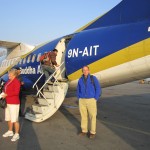

 Yes – “the top of the world” is what we often think about when we think of Nepal – or more specifically – “Mount Everest” – the tallest point of land on our planet. Clearly, the limits on my time and work activity here do not allow for the typical 13 day “Everest Base Camp Trek” that is required to get there (assuming of course that I am even able!). But there is a “Plan B” approach – and that is the early morning “Mountain Flight” from the Kathmandu airport that takes a quick one-hour “fly-by” of the mountain range – pointing out several of the tallest mountains in the world that occur here.
Yes – “the top of the world” is what we often think about when we think of Nepal – or more specifically – “Mount Everest” – the tallest point of land on our planet. Clearly, the limits on my time and work activity here do not allow for the typical 13 day “Everest Base Camp Trek” that is required to get there (assuming of course that I am even able!). But there is a “Plan B” approach – and that is the early morning “Mountain Flight” from the Kathmandu airport that takes a quick one-hour “fly-by” of the mountain range – pointing out several of the tallest mountains in the world that occur here.
So – there we were – up bright and early at 4 AM – to the airport by 5 AM – and after some rather confusing line-ups, ticket sales, tax payments, pat-downs, another pat-down, and then a third pat-down – we were on the “Buddha Air” plane – and eventually rolling down the airstrip into Nepali airspace – by 8.15 AM or so.
A short but wonderful flight; the pictures speak for themselves….
Holi
Celebrating the Holi festival
The Holi festival was on last Saturday – and even though we were warned about the possible consequences – we went anyway – wearing some nonessential clothes…As the CNN website says… “Holi is regarded as one of the greatest festivals, as important as Dashain and Tihar or Dipawali. Since more than 80% of people in Nepal are Hindus, Holi, along with many other Hindu festivals, is celebrated in Nepal as a national festival and almost everyone celebrates it regardless of their religion, e.g., even Muslims celebrate it. Christians may also join in, although since Holi falls during Lent, many would not join in the festivities. The day of Holi is also a national holiday in Nepal.”
“During Holi, people walk down their neighbourhoods to celebrate Holi by exchanging colours and spraying coloured water on one another. A popular activity is the throwing of water balloons at one another, sometimes called lola (meaning water balloon). Also a lot of people mix bhang in their drinks and food, as also done during Shivaratri. It is believed that the combination of different colours played at this festival take all the sorrow away and make life itself more colourful.”
In other words – everyone runs around throwing bags of colored water – or even more popular in the main Thamel district of Kathmandu – is that everyone walks around with handfuls of dry colorful pigments – and come up to you and smear it over your face, etc. Thousands of people are so colored – and this picture is just one group standing around during the middle (muddle?) of the day.
And – for the chronically curious among you – yes – it all washes off easily with a bit of soap and water …
(Remember to click on the photo for the full image)
(http://ireport.cnn.com/docs/DOC-575565?ref=feeds%2Flatest)
Farming is a family business


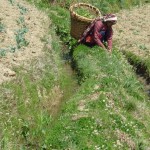 Farming is a family business in Nepal. These pictures show an individual terrace where cauliflower is being grown. These plants were initially grown as seedlings and then transplanted into the soil that was tilled by hand and hoe – and/or plowed by water buffalo. The bags that are scattered through this field contain fertilizer or compost, and each plant is individually treated by hand with both. Watering is also done by hand – and buckets of water are collected from a nearby stream, carried to the terrace, and then ladled onto individual plants as required.
Farming is a family business in Nepal. These pictures show an individual terrace where cauliflower is being grown. These plants were initially grown as seedlings and then transplanted into the soil that was tilled by hand and hoe – and/or plowed by water buffalo. The bags that are scattered through this field contain fertilizer or compost, and each plant is individually treated by hand with both. Watering is also done by hand – and buckets of water are collected from a nearby stream, carried to the terrace, and then ladled onto individual plants as required.
The mother and father are doing most of the field work, whereas the daughter is hand-harvesting various types of forage from the edges of the terraces, and will carry these back to the familiy home in her basket for feeding to the farm animals. Farm animals may include combinations of chickens, goats, water buffalo, cows or pigs. The specific animals present at each farm varies according to the type of farming they do, their family culture, and their religion.
You can see the drainage ditches that run through the terrace – mostly to drain away excess water during the rainy season. This is one of the more progressive farming families in the valley, and the father had completed a 5 month course in integrated pest management of cole crops.
“Hill farming” in Nepal


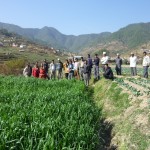
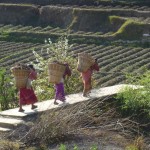
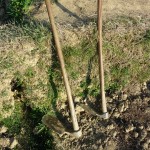
 We spent two days visiting the Bajrabaraha Village District Committee (VDC) in the Makawanpur district of Nepal. This is an area of “hill farming” about 1-1.5 hours outside Kathmandu – “as the crow flies”. However, it took us 4-5 hours to get here “as the jeep drives” – over rough roads, up and down, and in and around the mountains.
We spent two days visiting the Bajrabaraha Village District Committee (VDC) in the Makawanpur district of Nepal. This is an area of “hill farming” about 1-1.5 hours outside Kathmandu – “as the crow flies”. However, it took us 4-5 hours to get here “as the jeep drives” – over rough roads, up and down, and in and around the mountains.
The scenery is magnificant. The “hills” are actually small mountains – ranging up to 2500 m in height. The mountains have quite steep sides – allowing for wonderful views of the scenery as one drives along. However, looking down can be a litle intimidating at times – especailly when your jeep has to pass a speeding bus going the other way – on a single lane dirt road – on a hair-pin turn – while going over a bridge – with everyone honking their horns continuously; which was a fairly regular occurrence…
Much, or even most, of the sides of these hills are farmed. The farmers live in family and small village units along the roads. All of the land is farmed as layered terraces that have been hand-dug over many years – and constantly maintained. There are hundreds of thousands of them – everywhere. The terraces are maintained with a relatively large, heavy “hoe” and the terraces are hand-plowed using water buffalo. All seeds, fertilizers, composts, water, etc., are carried to the terraces – usually in baskets – and usually by women.
We visited at the tail-end of the winter cropping season and many of the terraces were “between crops” or had just been planted with potatoes. The main crops that were still present within the fields included cauliflower, cabbage, raddish and oilseed Brassica (e.g. cole crops). Smaller plots of onions, leafy spices, and wheat were also being grown on some farms.
We spent much of our time in meetings with members of the local cooperative, and then one afternoon walking around parts of the valley – talking with various farmers about disease and pest problems – and what methods they were using to manage them.
Off to work

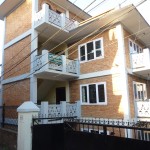
 Of course, the main reason I am here is to go to work – so off to work I go from Sunday to Friday each week (yes, that’s six days per week). To get to work – I need to travel from the northeastern side of the city of Kathmandu to the central region of the adjacent city of Patan. In the morning I use a “tuk tuk” or “tempo” (Photo 1) – where I typically ride along with 8-12 others for 40-45 minutes – and all for the modest price of approx. 25 cents. The tuk tuk is an interesting vehicle – its main merit is that it is 100% electrically powered by a series of 12 car-sized batteries – and therefore makes an enormous contribution to reduced pollution in the city. On the other hand – “part of me” gets the impression that they might also benefit from some shock absorbers!
Of course, the main reason I am here is to go to work – so off to work I go from Sunday to Friday each week (yes, that’s six days per week). To get to work – I need to travel from the northeastern side of the city of Kathmandu to the central region of the adjacent city of Patan. In the morning I use a “tuk tuk” or “tempo” (Photo 1) – where I typically ride along with 8-12 others for 40-45 minutes – and all for the modest price of approx. 25 cents. The tuk tuk is an interesting vehicle – its main merit is that it is 100% electrically powered by a series of 12 car-sized batteries – and therefore makes an enormous contribution to reduced pollution in the city. On the other hand – “part of me” gets the impression that they might also benefit from some shock absorbers!
I work at the National Agriculture Cooperative Central Federation Limited (NACCFL) (Photo 2) which is the umbrella organization of the Small Farmers Agro Cooperative Limited (SFACL). “Small farmers” in this context refers to farmers with very small landholdings (rented or owned) of typically 0.5 acre in size, and with annual income below the poverty threshold. Various definitions of this poverty threshold exist but – in round numbers – this would be less than $0.75 per day income. Humbling indeed.
Most of these cooperatives are located in villages well outside of Kathmandu – and travel to visit them is apparently slow – mostly due to poor roads and high traffic. Many of the villages are in the southern terai (grassland) regions – which are semi-tropical to tropical – and where much of the better agricultural land is located (about 6 hours drive from Kathmandu).
The SFACL is a truly cooperative organization that is fully owned and managed by the local community. Within each village – 3 to 14 families comprise an individual cooperative – and these are then organized into larger regional and district groups – with members from each cooperative responsible for managing the larger groups. In 2010, the collective membership includes more than 200,000 members. The NACCFL and SFACL provide a range of financial and nonfinancial services for its members – ranging from microfinance loans to plant and livestock health programs. For example – two other Canadian volunteers here include Amy – who is training people in statistical software for a microfinance agency – and Claire – who is a veterinarian helping with animal herd health.
For the first few days I have mainly been involved with meeting everyone, discussions and planning on what and how to proceed during my short time here – and a lot of reading on the NACCFL and SFACL, crops and crop problems that occur here, previous projects and initiatives that have already been completed, etc. Nepal clearly has an established and active plant health program already but are very understaffed – and small farmers tend to be underserviced.
Apparently, we will be heading out to the villages later this week for some farm visits and discussions…
At the end of each day – I take a bus home (Photo 3).
Kathmandu site/sight-seeing



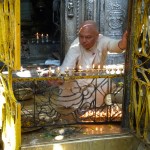

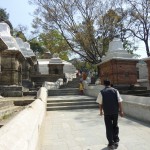
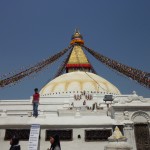


Photos 1-3. As the guidebook says “The Kathmandu Durbar Square holds the palaces of the Malla and Shah kings who ruled over the city. Along with these palaces, the square also surrounds quadrangles revealing courtyards and temples.” Perhaps more simply: “temples, temples, more temples and then even more temples” – all within an area of 2-3 blocks. The initial construction of the place is thought to date back to the 10-11th centuries – but the temples are considered more modern – dating back to the 15-16th centuries. The construction of the various buildings reflects the evolution of various dynasties and rulers – their and favored gods and goddesses over time.
Photos 4-6. The crematorium is a rather sombre but important place within the city – located along the river. A wide variety of goods are for sale by numerous street merchants along the path – including the stands of brightly-colored pigments (e.g. Colors). At the end of this path is a large building that stretches along the river – with 4-10 funeral fires burning under canopies at any one time – with families tending to the fires and the ashes (no pictures – out of respect). Extensive grounds, stairs and related structures are present at this site.
Photos 7-9. The Great Stupa of Boudhanath presents a complete contrast to the crematorium. As one walks down another street and turns the corner – one is immediately accosted by a great white done, with two large eyes, and thousands of colorful prayer flags fluttering in the wind. This one of the holiest Buddhist sites in Kathmandu, one of the largest in the world, and is a UNESCO World Heritage Site. The Stupa is on the ancient trade route from Tibet which enters the Kathmandu valley. Tibetan merchants have rested and offered prayers here for many centuries. The Stupa is said to entomb the remains of Kassapa Buddha, the third of the five Buddhas of the “Fortunate Aeon” (you can google for more info).
Orientation …
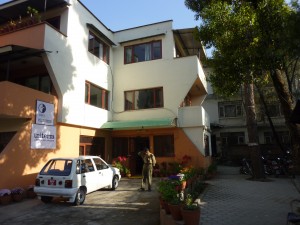
The sounds of barking dogs, crows, motorcycles, temple bells, and braying cattle help wake me each morning. Our agenda for the first two days in Kathmandu was an official orientation from our sponsor agencies at the CECI offices (left side of photo) which are located in the same compound as our accommodations in Passage House (right side of photo). A full day of meetings, including a surprise visit from the regional CIDA representative. Everyone is very organized and helpful. The next day started with a full medical interview and orientation, and then a quick tour of three sites around the city; the Kathmandu Durbar Square, the Kathmandu Crematorium, and the Great Stupa of Boudthanath (pictures will follow soon).
(Note: you can click on images within the blog to get the full image).
The trip …

The trip ...
So, how does one get to Nepal? Well – I left Toronto (#1 on map) at 1:30 AM on 5 March on Cathay Pacific – and flew to Hong Kong (#2 on map; 15 hours, approx. 12,500 km) – and then had an 11 hour layover. I met up with Amy – a fellow volunteer coming from Vancouver – in the airport in Hong Kong. Next we took a Cathay Pacific flight from Hong Kong to Dacca, Bangladesh (# 3 on map; 4.5 hours, approx. 2,400 km) and then took the final flight into Kathmandu, Nepal (#4 on map; 1.5 hours, approx. 675 km). So – all totalled – the flights covered approx. 15,575 km and took 37 hours. We were met at the airport by Shashi – our friendly agency driver – and delivered to our accommodation – where I promptly fell into bed and asleep!
Day 2
Slept almost ten hours last night! Feeling fresh this morning and lovin’ taking my time. Went for breakfast at 8 thinking it was going to be laid out… another false expectation. A young man walked me to the dining area and gave me the options – eggs, fried, eggs, scrambled, eggs, omellette, sausage, bread, white. OK, omellette and white bread it is. So much for the market fresh fruits and yogurts I had on my mind. And surprise of all surprises, some powder Nescafe makes so called real coffee or something crass like that. The north makes great coffee, so why isn’t it used here.
My omellette wasn’t bad and the toast filled me up, but I grabbed juice, apples, yogurt, cheese at the supermarket today. The highlight was my conversation with Agostino. He is a 23 year old Malawian who lost both parents to illness, and supports his younger brother and a grandmother who raised him. He is charming and a very practical young man.
The morning at WUSC was worth it just to meet the folks there. Content wasn’t very engaging – seen and heard it all before, but like all Malawians so far, they were friendly and helpful. Went out chauffeured by Phalys again who took his to change money, buy a phone and hit the supermarket. I came home to get myself settled. Tomorrow I will meet Charles with Alice who will be the go between.
Put in an order for dinner, fried chicken and rice and it came with green beans. Yummy! Drank some of the SA white I bought at duty free in SA, worked out my cell phone, and chillaxin in the room. Turns out I am 1 of only 2 guests at the lodge right now and she’s going in a couple of days. Chickombi took me to meet her and we had a brief chat. Don’t expect it will grow into a meaningful friendship, but got some good tips re. travel to Lake Malawi. Could be a lonely existence for the next while.
I meet the client tomorrow – Alice will introduce us. I will find out who my contact is, then downtown to meet Roy and Billi – 2 others!
Leaving Accra
Sitting in the lounge in the Amsterdam Airport, I am still groggy from the overnight flight, not quite long enough to get a good night’s sleep but long enough and late enough to engender traveller’s disassociation, that strange, not-quite-fully conscious state where everything is seen through a lens of fatigue and yawns come unbidden in an attempt to find sufficient oxygen after airplane air.
The waning days of my sojourn in Ghana were eccentric and confused. I couldn’t get my departure date clear in my mind and kept telling everyone – the Child’s Rights folks, WUSC, Suma and my friends – that I was leaving Friday. I wasn’t; Saturday had always been d-day. The funny thing is that this confusion wasn’t some weird subconscious desire to leave early. Rather, it really was more about not yet being ready to leave.
There is a tradition, in Accra, amongst the WUSC volunteers that, prior to returning home, a volunteer’s WUSC friends and colleagues gather for a farewell dinner at Suma Court, as if to close the circle that begins when the tired excited curious nervous new volunteer steps off the plane and into the embrace of Suma Court. Juliana and I conferred about the menu, how best to accommodate various likes and dislikes and a vegetarian. We had chicken, fried plantains (my favourite: any day with fried plantains is a good day), jollof rice, red and spicy, and the most exquisite spaghetti (not something I expected to find in Africa), and french fries (comfort food for Canadians here for a long time). There are bottles of Stone beer and then, the real surprise: strawberry ice cream.
I wonder about departures, about saying good bye, about promising to return.... and I do promise. When the time comes all the Suma denizens gather in front. Nicholas runs up to me and I carry him outside (can that really be me with a two-year old clinging to her?) Hugs all around,.... even Peace and Daniel hug me and Juliana and I hug like sisters. Patrick is there with his taxi, the really new one, and the bags are loaded. Somehow, I still have all the suitcases and yet one more package, as well. And as we leave the Suma courtyard everyone waves until the taxi turns out of sight. Patrick comes into the airport with me just on the off chance that I cannot finesse my oversized, bizarrely wrapped (in a tightly tapped, psychedelic purple bag) onto the plane. But the amazingly accommodating attitude of Ghanians continues through the KLM check-in and right through security. No one seems to think my purple plastic bag is the least bit unusual. (It contains two old carved window shutters for traditional huts, one from Mali, one from Burkina Faso. They would be closed during times of war and are carved with warriors and other figures including rats, that would protect the inhabitants of the huts. They speak to me in a way that souvenirs cannot).
So, leaving Accra is decidedly different from arriving. Anticipation has been replaced by wistfulness. I am so pleased to have made a contribution to the work of Child’s Rights International but I am definitely not ready to leave Ghana. Here in Amsterdam airport, in this artificial liminal environment, time and place do not exist, and it is thus that slowly, slowly my shoes turn and like a compass needle finding to true north, start to point towards home....
City of Walls
Initially, Accra appears to be a walled city. There are walls everywhere, keeping something out or keeping something in, guarding, hiding, protecting, sheltering. There are tall walls and small walls, sturdy walls, impregnable fortress walls, mud walls, brick walls, cement walls, wooden walls, walls of leaves. There are smug walls, painted soft pastels of yellow and green and pink. There are walls with lovingly wrought iron gates proudly sporting gilded finials of faux gold. There are shabby walls, nothing more that sheets of corrugated iron propped up, standing against the odds, the gate no more than one iron sheet loose enough to pull back and squeeze through. Not unusually these spectacularly different walls stand side by side: for the most part, rich and poor are not separated in Accra’s urban geography, impoverished Christian Village, privileged Achimota and the egregious embassy enclave notwithstanding.
Relying on neither sheer height nor great width, many walls sport nasty dangerous toppers which, in the right light can twinkle like tinsel, outlining the shape of the land they bind. Some are familiar – pointed bricks or broken glass and bottles. Other bristle brutally: barbed wire and electrified wire are prominent. Increasing popular, too, is razor wire, inexplicably favoured by the ubiquitous evangelical non-denominational, conspicuously wealthy churches that serve the poor. Razor wire is a more recent innovation, mandated to surround the dwelling of every employee of the US Embassy, rendering these overly cautious Americans visible to all: vandals, kidnappers or terrorists alike. In Accra’s ongoing Were’s Waldo, in which direction signs, street names and addresses are all eschewed, these razor wire bedecked walls are as effective as searchlights to identify their American inhabitants.
These walls of protection are easily comprehensible but what of the flimsy walls, the walls to low to even cause a tumbling Humpty to break? Walls that are propped up. Walls without any gates at all, wide openings that invite in the world. There are pristine walls and walls that serve as billboards. There are, among the hundreds and thousands of walls, a few with spray-painted messages that at last hold the key to understand the walls, especially that do not enclose or protect. The painted messages: “Family owned land.” “Land not for sale.” “Stop work. Produce permit.” “Remove immediately by order.”
Land ownership in Ghana is not clear. Title offices, deeds, registered mortgages are for the most part inefficient, inconsistent or nonexistent. One of the only ways to prove and enforce ownership is to erect a wall and literally defend it: “Keep off. Family land. Not for sale.” What happens is that unscrupulous people pretend ownership of a parcel of land that does not belong to them and sells it to someone who thinks it is a legitimate sale, but of course it isn’t. But who knows? And when does a person find out that the dream plot of land they have saved their whole life to purchase is not theirs at all and they have been defrauded. This is also why people start to build even the most rickety partial structures: to prove the land is occupied.
Building reveals the astonishing disparity between new Ghana and old. There is an enormous, multi-story Novatel dominating the skyline hitherto limited to about 3-5 stories. And the churches, these are the other big construction projects, immense, elaborate, with detailing, columns, cornices and balconies. They stand in stark contrast to the surrounding neighbourhood echoing the same dissonance that characterized medieval town and medieval cathedral, absent only the gargoyles. But large or small, multinational or evangelical, commercial or domestic, there is one thing that unites in Accra: they are all made of cement, poured cement, moulded cement or towering stacks of cement blocks held together with cement. The roads are lined with cement brick works, where the workers make standard rectangular cement blocks, or coloured decorative blocks, all by hand. Vendors show varied styles and sizes of decorative columns to grace the entrance or hold up the ceiling.
Construction sites dot the roads as owners rush to build some structure that will reify their claim to the plot of land. Workplace safety standards appear to be unknown: the workers don’t wear hard hats; one assumes that steel-toed boots are equally absent. But absent also are safety harnesses as the construction workers stand of frail wooden scaffolding, devoid of railings, presumably too unstable to support a worker in full safety gear. The drop might only be a storey or three and the ground is soft but how many construction workers and cement workers are injured, disabled, killed every year? Occasionally, the walls of the construction sites bear a spray-painted notice “Stop work immediately. Produce permit.” This is how the building inspectors try to impose order on an essentially uncontrolled and uncontrollable industry. There are too few inspectors to return to a site where there is never anyone really in charge or responsible, so they leave their calling card. Wily owners and construction crews, however, not infrequently paint these signs themselves, to trick inspectors into thinking a colleague has already put the site on notice.
If construction sites dot the landscape so, too, do the skeletons of half built structures. Sometimes it seems possible to read the ebb and flow of Ghana’s economy by the age of the building and when construction stopped. This may be fantasy but certainly when the owner runs out of money construction does stop, only to resume when there are again sufficient cedis for a roof or another storey or the external stucco and painting. Suma Court has been under construction for 20 years and there are still plans for additional rooms and amenities as funds become available. It gives one pause the consider that no one in Ghana has a mortgage: but with interest rates having just gone down to 24.9% perhaps therein lies explanation. Certainly, though, some of the skeletons are the result of downward mobility. Across from the WUSC office is a house, grand and walled and crumbling. The window glass is broken or gone completely and an enormous satellite dish, surely the size of the whole roof, has fallen. But even in these hard circumstances, the owner is seeking to enforce his rights; spray painted on a vendor’s booth that has tried to encroach on his wall space is a notice to remove immediately.
So, the booths of the vendors huddle under the walls of the wealthy (though not in the embassy enclave which could blend into Rosedale or Shaughnessy or any similar neighbourhood) who become all the more wealthy for the presence of the vendors who rent their squalid square of boulevard from those behind the walls. The vendors, dependent though they are for their land, are nevertheless independent merchants; they not only own their skills and stock but also their shop that rest on the land of the bourgeoisie.There is something in all this that compels the language of Marx, a radical call to social justice: workers of the world unite; you have nothing to lose but your chains. Except some of the poorest vendors and the hawkers don’t even have their own chains, no doubt melted down with the global economy.
Random Accra
There are so many things that one encounters here that are worth mentioning, random though they are. So here goes a digest of random reflections. No logic. No chronological order.
Slow Down. Golfers Crossing: About halfway in my commute there is a lush green swath that provides cool shade and a respite from the endless red dust of Accra. It comes upon one almost out of nowhere and suggests that once Accra may have been the site of farmers’ fields and rich wild vegetation. It is as surprising as when one suddenly is enveloped by Stanley Park or High Park or even Central Park, more appreciated because more unexpected in the surrounding urban chaos. It took some time to ascertain what those verdant hedges are hiding from the endless stream of cars and taxis and tro-tros. It is the Achimota Golf Course. The tip off was finally noticing, in the chorus line of signage that forms the boundaries of the street, a sign: Slow Down. Golfers Crossing. Such a sign can only reveal one of two world views: the hubris of the privileged or the triumph of hope over experience, because there is no way, absolutely no possibility, under any circumstances, that Accra drivers will slow down for anybody ever.
Another utterly baffling aspect of this golf course – if anything can be more baffling than golfers crossing this road to move from one hole to the next – is a form of hazzard never before encountered in my experience. Each tee box and each green that I can see through the trees from my taxi window, is surrounded by enormous advertising bill boards, standing on all sides except the direction that one hopes to hit the ball. They positively loom over tee or green, at least twenty-five feet high. Certainly, Ghanian golfers must have prodigious powers of concentration to come anywhere near to par.
Fridays: Canadian workplaces used to have Casual Fridays, a practice that has morphed into perpetual sloppiness in too many contexts. In Ghana, people dress far more smartly for work: it reminds me of the 80s or 90s. Ties, skirts, and so on. But here there is also a change to the dress code on Fridays: people wear either traditional dress or organizational dress. Last Friday I was fully inducted into CRI by receiving two polo shirts with the CRI and EU logos and, emblazoned on the back, Justice for Juveniles. Very smart. In two shades of blue (light and royal). Now I’m a full-fledged member of the team.
Signs, signs, everywhere there’s signs:
Sand and stone for sale: why in a place with a superabundance of both?
The President of the Republic of Ghana, holding a stylized World Cup: Let us rally round the flag and support the Black Stars.” The newspapers report that the Revenue Agency is now about to go after all the bonuses the soccer players received for doing so well. In the World Cup. What if they had won, I wonder?
In the Dzowrulu section, where I work: House to let. Nice 4 bedroom and boys. Some things cannot be glossed.
Hotel Obama
Seamstress and...?
Ghana is renowned for its cloth. The best known is kente, the heavily woven and extremely bright cloth worn by men of standing in the south. Less is said of the amazing fabrics and prints of women’s clothing, and of the fact that cloth can be bought virtually anywhere from a swish boutique to a craft market to the mall to the ubiquitous vendors. I even noticed one hawker with cloth one day walking through the traffic (surely too dusty to sew?) Every block seems also to have one or two free lance seamstresses who will whip up anything you wish. If they don’t have a pattern, just describe what you’d like.
I purchased some cloth, not inexpensive by Ghanian standards, at the African Queen boutique, which has the distinct advantage of being conveniently located around the corner from the office. She took me to her friend the seamstress, hidden behind an enormous wall and corrugated iron gate. Without a sign she was invisible. Going inside the gate was astonishing. On the front porch were a mother and three or four younger women, sewing like mad on hand driven sewing machines. Not one foot pedal machine, let alone an electric sewing machine. Some of the women were daughters, others seemed to be young apprentices. As I stood on the porch being measured, I watched the family’s other business in action: a small cat, with a loader, moving what looked to be dead car transmissions from one pile to another. I don’t know what they do with them. Scrap them? Refurbish them. Or just collect them? This also is the only place I have seen a kitten: a pet certainly, but so mangy and scraggly and thin that only an irrational fear of rabies kept me from scooping it up and carrying it off.
One last thought: will my jackets smell of transmission fluid?
Justice for Juveniles
The Executive Director of Child’s Rights International is Bright (no pun at all and, yes, he really is) who left a career as a teacher to run CRI. He is a soft-spoken man who comes across as gentle and caring. I suspect that is why kids trust him. As part of he current project on justice, Bright was filmed interviewing children in jail about their experiences. The children are so forthcoming about their misdemeanours – certainly not crimes – and matter of fact way in how they describe parental neglect, judicial indifference, unreasonable sentences and unspeakable conditions in the detention facilities. It is a rivetting documentary and throughout the interviews Bright’s eyes do not break the gaze that holds the child and lets him or her speak their truth. Nor does he flicker an eyelash as the children reveal the most egregious breaches of their legal and civil rights.
CRI works on various projects that include lobbying the government for legislative reform or working with the government to promote issues to enhance the well being of children in Ghana. This is a complex issue for Ghanians. There is real appreciation of children as the vulnerable foundations of the country’s future and well-being. Ghana was the first country to ratify the UN Convention on the Rights of the Child. But Ghana is also among the poorest of the developing countries (in the bottom 18%) so money for programmes and improvements is scarce and there are always multiple competing needs. So every two or three years CRI devotes its energy on a specific issue, looks for partnerships and launches major projects to have maximum impact.
The current focus – I believer this is year two of three – is on Juvenile Justice, in partnership with Plan and UNICEF. The project was awarded over 800,000 euros by the European Union. CRI has gone to five regions of Ghana to establish Rights Clubs in which children learn about and discuss their rights. Some of the focus group posters show that children fear the law and police officers, not much of it misplaced. My contribution has been to write an accessible, child-friendly version of the Juvenile Justice Act. This will be tested in the field with children and they will also be asked to draw pictures of key points. Their drawings will then illustrate the printed version. I have also written a brief overview that tells kids what to expect if they are arrested. This is intended to reinforce their knowledge of their rights and also dispel some of the fear of the unknown and what will happen to them. There will also be a pocket version with cartoon illustrations that will be widely disseminated to children.
My current projects include assessing a call for researchers and advising on whether CRI should apply for a contract. The call is to do country-based research in one or more of 6 countries, to assess their legislation as it pertains to children and the extent to which the country is moving into compliance with the UN CRC and the African Charter on the Rights and Welfare of the Child. CRI has already done this brilliantly for Ghana so will be well-placed to apply its expertise in other counties.
On the horizon, an application for funding to assess child labour, a topic far too closely related to juvenile justice, as are poverty and illiteracy. Sadly no surprises there but much energy around to address these challenges. CRI is a great partner organization and one that is making a real difference.
Taxis and tro-tros
Most Ghanians take tro-tros, a far less reliable, less efficient and less expensive mode of quasi-public transportation. Tro-tros are basically like vans except very old, verging on falling apart. They have four rows of seating (at least the ones I’ve ridden) with anywhere between four and six passengers per row. On Saturday I rode one with 21 passengers plus conductor plus driver. The last seat at the right hand end of each row is folding, so the back can be pulled forward and then the whole thing flipped sideways to make an aisle-like space. To move in and out of the back rows everyone on the end seats has to get off and flip their seat up; so, too, anyone in the row blocking the person wanting to exit. This makes for considerable chaos at every stop. Most African countries have a similar form of this transportation, it is not specific to Ghana.
Tro-tros seem to be private operations but are a recognized part of the city transportation system. There are regular stops and routes and specific beginning and end points but there is no schedule or timetable. They sit until they are full and then they leave, dropping off and picking up people at the stops and also randomly. People can simply stand at the side of the road until a tro-tro comes by, which they will certainly do eventually. The conductor shouts something utterly incomprehensible, rather like hecklers at a ball game or drill sergeants who can’t really be understood. He also waves his arms in specific ways which indicates the route and so people can flag down the correct tro-tro. Everyone just jumps on and at some point or other the conductor asks for the fare. Not that the fare is ever really clear or set, as this weekend’s adventures demonstrate.
On Saturday, I went with Daniel, one of the Suma Court staff, to an amazing craft market clear across greater Accra, right on the edge of the ocean. We went by tro-tro which was cool. Daniel had been a tro-tro conductor and after all, Accra is his town. We jumped on, did the requisite shuffling and jumping on and off as necessary, folding up our seats and gradually moving up to better seats as old riders descended and we were able to outwit the new riders and get better seats before they got on. Our ride took an hour. It was pretty rough between the crowded benches, the dust and fumes etc etc see above. It cost us each 65 peshwas, about 50 cents.
Flushed with success, today I ended up taking a tro-tro with a group of Australian volunteers who have just arrived. They were keen on tro-tros and wanted to go to the mall, as did I. I was unsuccessful getting the first taxi at a decent rate, and a tro-tro stopped in front of us. Because I was speaking to the obdurate taxi driver, I didn’t see how the conductor was waving so I asked if he were going to Accra Mall and he said yes, get on. So we did. The only trouble was his English was negligible and the tro-tro was not headed to the mall. After a bit they drove off the route to the mall which I know well enough to realize something is up. So, after a lot of discussion between me some of the Ghanian women, and then they with him, it was settled that the tro-tro would take us to Atomic Junction where we could get a taxi to the mall. Cool. When we got to Atomic Junction, however, another tro-tro was there going to the mall and the conductors arranged a transfer. Except conductor #1 wanted 3 cedis for taking six of us out of our way. In the end, I paid him 2 cedis. Then we carried on a straightforward route, paid 1 cedi 80 peshwas and the lovely conductor even showed us where and how to cross the three-lane divided highway to get to the mall, a not self-evident challenge.
The nice thing about this story: Daniel tells me I paid the first conductor the right amount and didn’t get over charged.
How hot is it?
How hot is it? It is breathtakingly hotter than it was in Botswana and walking through the endless sand of the Kalahari, proving what they (whoever they are) always say about “but it’s a dry heat!”
How hot is it? It is so hot that the back of the cheap Sears watch I bought to bring on this trip ($19.95 and some swirly writing suggesting it might actually have a make but who can read the little swirls?) is rusting from the sweat of my wrist. I kid you not.
How hot is it? It is so hot that when I walk into an office where normal people are working quite comfortably, they take one look at me, are overcome with compassion and rush to turn on the air conditioning. It seems rivulets of sweat running down one’s face is undignified.
How hot is it? It is so hot that I haven’t even bothered to complain about the heat.
Hawkers and Multitasking
The other intersection of shopping and travelling is found on the streets themselves. Hawkers are found in every direction, fanning out from an intersection or junction or even in the middle of the ubiquitous construction sites which cause traffic to grind to a halt. These hawkers are not at the side of the road. Sometimes they are on the medians separating lanes, more commonly they wander through the traffic between the moving cars. The best place seems to be between the two northbound/southbound/whichever direction, lanes, ones going in the same direction, that is. Then the hawkers have twice the opportunity to sell their wares, compared to those that stay more safely on the median or on the side of the road. The hawkers are male and female and range in age from young – maybe 11 or 12 – to adults, mostly in their 20s and early 30s I’d guess, but some much older hawkers are also evident from time to time. At least half of those I’ve seen do not wear shoes, a scary thought on pavement or concrete sitting all day everyday under the burning sun. The men mostly turn themselves into ambulatory display racks with items hanging off them in every direction, looped around their necks, hanging down their backs and swinging from their long arms. Except for those who sell lottery tickets or newspapers: their wares seem more controlled, smaller, less like they’ve exploded from the body in all directions. The women, and some of the men, carry their wares balanced on their heads, weaving in and out of the traffic, graceful and unperturbed. Nothing every falls off. None of the towers of goods seems to totter or swerve. Some of the women balance towers of items that are at least two feet high, not tall bins filled with things but rather towers of small items stacked somehow more securely than seems possible. The women walk as they would have in the villages of the past, tall, with perfectly straight backs and exuding utter confidence. But it isn’t only the hawkers who carry on their heads: I’ve seen housewives carrying the laundry home in this way too. There is such elegance and gracefulness involved in this dance of incredible balance: it is easy to understand why the colonialists romanticized what is, at its most fundamental, a form of human labour.
The hawkers walk up and down between the cars, looking inside, calling out their wares. It is easy enough in the slow traffic of Accra to call someone over and dig out a cedi or two and buy something, anything, well, truth to tell, everything. It seems that one could almost do a household’s marketing from the back seat of a taxi, en route to and from work. So, I’ve decided to see if this is true. What follows is a list of what the hawkers offered as I came home from work. Note: the goods are only from the street hawkers and do not include the even greater diversity offered by the booth merchants. And the list is necessarily incomplete: I don’t always know or recognize what is for sale and can’t gawk too long or I’ll have to buy something. So, here goes: remember, each individual item (unless otherwise noted) has a specific hawker (the lottery guy doesn’t sell newspapers). Items are grouped roughly by type for the reader’s convenience.
– lottery tickets, newspapers, magazines, Barney the dragon children’s books, phonecards for pay-as -you- go cellphones, DVDs (mostly recent Hollywood releases, probably pirated), CDs, poster size maps of Africa and Ghana, evangelical/religious books, crucifixes
– car floor mats, steering wheel covers, cell phone chargers for car lighters, superglue
– toilet paper, kleenex, rolls of elastic bandages, make-up & nail polish, toiletries & similar drug store items like aspirin. In this case, the hawker had a variety of items it a tower on his head that must have been two feet tall. How did he even know what he had?
– tea towels, bath towels, table clothes, hangers, sheets (assume with pillow cases), strange bedspreads (wall hangings?) that appear to be giant velvet animals, plastic Tupperware style containers
– Coke,& Sprite & local soft drinks, yogurt drinks (chocolate, vanilla, strawberry), hot chocolate mix, sachets of water (the kind Ghanians drink by foreigners shouldn’t; not in bottles but in plastic bubbles)
– plantains, bananas, pineapples, yellow apples, corn (on the cob), sugar cane, loaves of bread, pita bread
– bofru (sp?), a mix of corn meal cooked in a banana leaf, donuts, crackers, roasted nuts, banana chips, popcorn, donuts (more about those another time), cookies & biscuits (homemade & packaged), chocolate (in this heat?), Mentos & various mints & gum
– T-shirts, stockings, shoes (adult & children), sandals, jewellery, children’s clothing, scarves, flip flops (yes, I know, there’s a whole flip flop theme going on), wallets (leather), briefcases, baby bibs, shoe polish & brushes
– exercise equipment, soccer balls, stuffed animal backpacks (bears & raccoons), luggage, beachballs
– black and gold carved side tables, electrical cords, international converters for plugs, regular light bulbs, strobe-style lights to hook up to a music system, wall clocks in various styles, pictures (large for living room walls), electric fans
So, my highly unscientific survey suggests that a house could be partially furnished, dinner made, everyone clothed and entertained all from the back seat of a taxi: multitasking at its best..... but pity the poor hawker who makes it all happen.
On the Roads Again
Flagging a cab is more complicated than it sounds. It isn’t hard to get the attention of half a dozen taxis just by appearing on the side of the road. But that is only the first step. Next comes the negotiation. There are no metres in Ghanian taxis although they do have little yellow taxi signs on their roofs. The fare is a matter of negotiation: how much can the driver charge versus how little to you want to pay. Settling on an agreeable fare is like the dance of a Turkish bazaar, but infinitely more uncomfortable as the taxi idles on the shoulder of the road and the usual crazy traffic whizzes by with honking horns and belching smoke.
Where do you want to go? Dzorulou.10 cedis. Hahahaha. It should be 5 cedis. But today the traffic is bad. 5 cedis. Where in Dzorulou? (pronounced Jurulu) Inside. (I have no idea exactly what that means). 8 cedis. What about 6 cedis? Okay. Jump in.
The critical issue is to know what the fare should be and then negotiate according to traffic and whether it is rush hour. The flat rate means that here the driver bears the brunt of gridlock rather than the passenger. I did my first negotiation today, but it scarcely counted since my co-worker, who is shepherding me to work this week, was standing there with Eric, the hotel owner, the two of them scarcely able to keep a straight face as I launched into negotiations with the taxi driver. Nevertheless, by pointing out to the driver that he had already earned one fare bringing Brianna to Suma Court, I did manage to get the price down to 6 cedis. I think a Ghanian would have got it down to 5, a complete tourist would have been stuck with 8 or 9.
Spending so much time on the road probably gives me an unbalanced perspective on life in Accra but it also provides a window onto a variety of areas of the city. I work at one end and basically cross the town to go from Suma Court to the offices of Child’s Rights International. Part of the route is on a four lane divided highway which abruptly stops and turns into a two lane gravel road snaking through a construction site. Eventually, there will be a lot of highway, but for now there is only congestion that rivals the 401 at rush hour. A really good driver knows all sorts of back roads that let you detour around gridlock. Back roads in Accra means careening down the shoulder of the roadway, passing those unimaginative drivers who remain in their lane. No self-respecting taxi driver would stay on the paved road clogged with stopped vehicles. From the shoulder we enter a sort of alleyway, except that alley implies a certain breadth, possibly a straightway and a surface characterized by flatness. If the area never presumes to be flat, potholes are an irrelevant concept. The only thing that distinguishes the “alley” from a cow path is that it is narrower and in the midst of a city. The field we go through would be a farmer’s field except it is too uneven to plow and is littered with cars in various states of repair pushed there by the men who work out of a very shabby mechanic’s booth. We have to dodge around a fire burning garbage and blocking the egress, jumping instead over a ditch, more narrow than most, and ending up on a road of sorts. At this point, we enter Christian Village which appears no more Christian than anywhere else in Accra but is distinguished by considerably more poverty. The streets aren’t streets but winding donkey paths up hill and down, punctuated by enormous holes and dips (they can’t be potholes; there is again no pretense of flatness). The booths that everywhere look shabby are even more rickety here. Rather than the corrugated steel or railway box cars of Video Junction, these are little more than some weathered timber thrown together. For all that these booths look like they would not withstand a good huff and a puff from a predatory wolf, they are intended to be permanent. We are so early this morning that some are still locked with big steel locks that look to be more weight than the door can bear. And they have their names, of course: God’s Vineyard for wines and liquors, Manna for snacks. And then, as suddenly as we entered, we leave Christian Village and are surrounded by the large elegant homes of Achimota. This area is so unabashedly wealthy that there are no booths lining the streets, the only area of Accra I have seen without vendors everywhere. It is an enclave that could be anywhere and so desolate in its finery that it appears to be nowhere at all.
In no time we are in the crowded streets of Dzorulou, looking for the UBA Bank and the compound with the royal blue gates behind which is the office, florescent lime green and a hive of activity by Canadian volunteers from across the country.
Today’s challenge, like Gretel’s, to find my way home........
(Dis)orientation
The WUSC office is not far from Suma Court, so Annette, assistant to Patience, arrived on foot to walk me to the office. She showed me a convenient back route that doesn’t take us along the busy Atomic Road filled with morning traffic of honking taxis, careening tro-tros (mini vans that function somewhere between a taxi and an informal bus system) and myriad other vehicles of all shapes and sizes, from scooters to 18-wheel transports, with engines in varying states of repair, many spewing noxious and nauseating black smoke the likes of which I haven’t seen since an unfortunate walk in Oxford that ended with dry heaves on Madgelan Bridge, but that is another story.
Patience. What can I say except I’d do almost anything to have her on any team I was assembling. She is truly wonderful. Very smart. Very efficient. Warm and welcoming. Organized and flexible. We did the business of orientation. She asked me to draw a picture of myself on my sheet of expectations so she would know who it was. This was, of course, a big mistake and the funny egghead with Harry Potter glassed and spiky red hair was unexpectedly startling. She gave me information and advice. I asked questions. But mostly we laughed. Patience epitomizes old and new Ghana: a woman in traditional dress (the most amazing blue with pineapples) coordinating an army of volunteers from her laptop. This is someone who gets things done with an iron will and a smile. We ate fried plantains, chicken and red-red (a sort of bean stew) at her desk, and then we make the trek into Accra proper to the offices of Child’s Rights International, to meet the executive director and staff and other volunteers.
I am keenly aware that I have now gone up and down that road 5 times, from the airport, to the mall and back and now to CRI and back..... and yet I yearn for a landmark, for something vaguely recognizable from one trip to the next. Part of this is that the kind of stable markers we Canadians use are irrelevant on roadsides with an ever changing vista. Some vendors go home and others take their place. Some places seem to have more stable booths, while others clearly change from day to day as someone acquires a stack of tires to sell or comes from the country with trays of freshly baked bread or plantains or chickens (live) or a crate of puppies. These vendors come and go so they offer the stranger no point of reference.
One might think that billboards offer a stable landmark but even these seem to be in perpetual motion. This illusion is caused by the astonishing overabundance of signs of all shapes and sizes that line the roads and positively congregate and somehow add to the aura of chaos and congestion of the junctions. There are so many billboards and signs that one’s attention is constantly shifting. On the way from the airport it was Vodofone signs; today’s themes were different. First, at the junction by the Achimota School and Police Station, there was an astonishing trinity of giant billboards: the centre on roared, “Repent. Jesus is Coming Soon” while, like the two thieves on either side at Calvary, hung equally large “Castle Milk Stout. Smoothness Inside You” and “Guiness Foreign Extra. One Nation. One Game. One Beer.”
There are multiple advertising disjunctions that knock one off balance. There is a lingerie shop in the mall, much like La Senza or Victoria’s Secret, with the same skimpy, diaphanous underwear that wasn’t designed for more than 20 minutes of uncomfortable wear. The store mannequins are all white women in this very black culture. The same fascinating intersection of race and gender is mirrored on the numerous lingerie billboards but, from what I can see so far, these are virtually the only white faces in advertising.
There is another set of advertising signs and fliers that appear with overwhelming frequency and are in startling parallel. There are religious signs everywhere, some urging repentance, others advertising evangelical meetings or Christian conferences. Religion is reflected in more mundane signage, as well, the By His Grace Fitting Shop (tailor), the Black Jesus Barber Shop, With God Furniture or the God’s Time is Best cell phone booth. Equally evident, however, are the exhortations of educational institutions: come and upgrade your marks, gain foreign accreditation, TOEFL scores improved, study by distance, placements in universities abroad guaranteed, American curriculum, British curriculum and even Canadian curriculum offered. These dubious purveyors of one the most highly prized acquisitions in Ghana – a good education – promise people salvation and success akin to the evangelical promises.
So, with such distractions, I have yet to learn my way to the office..... maybe tomorrow......



